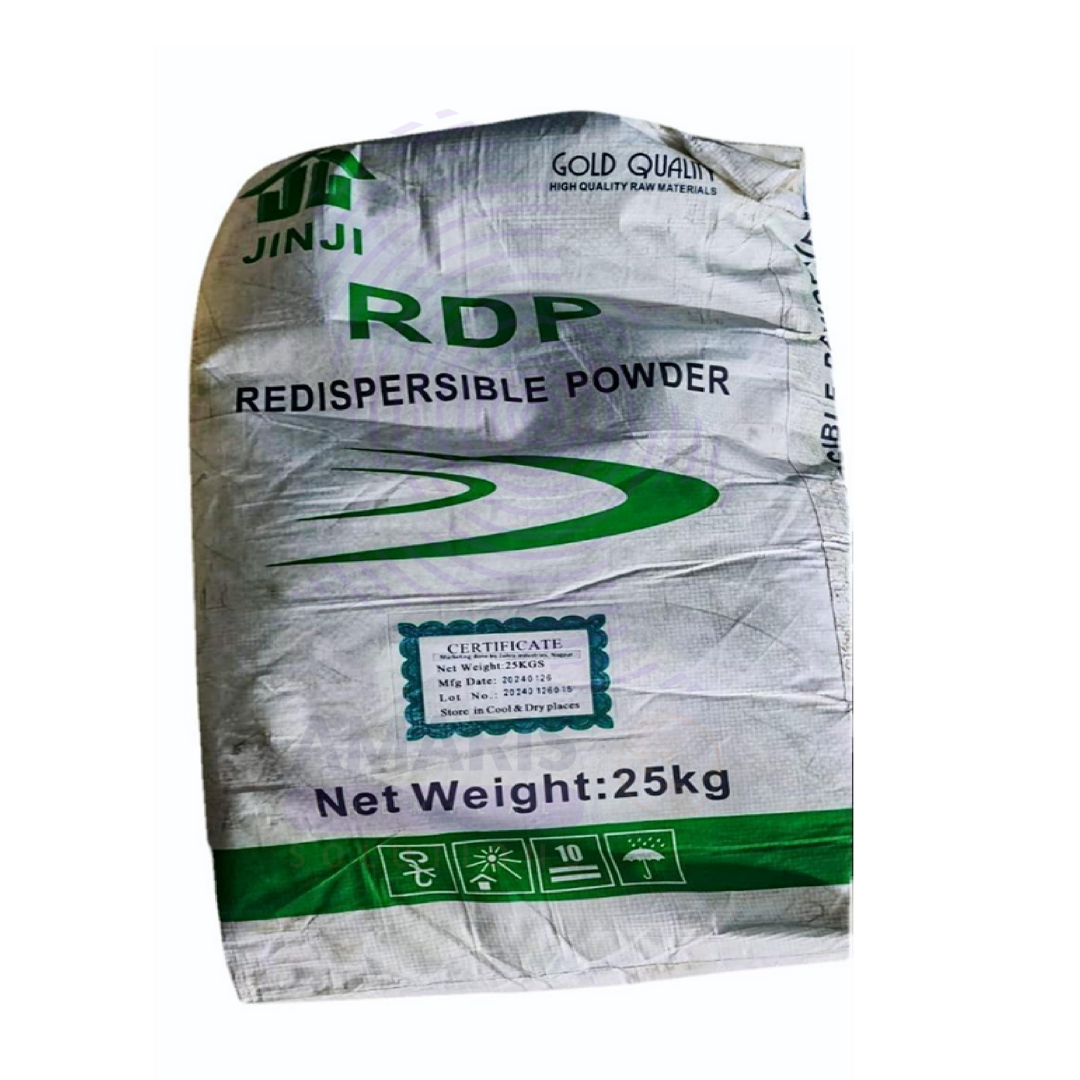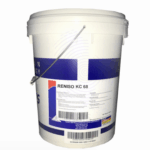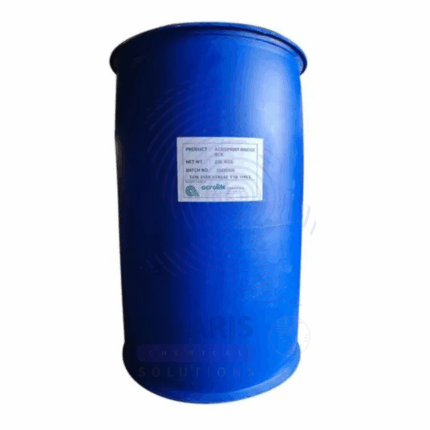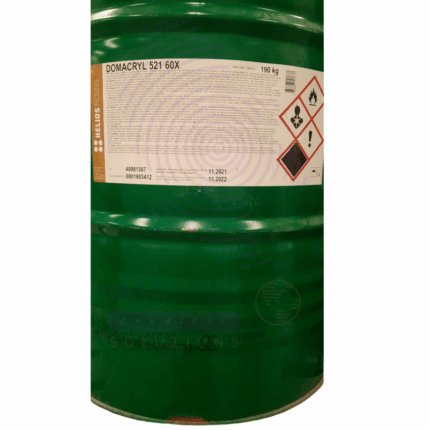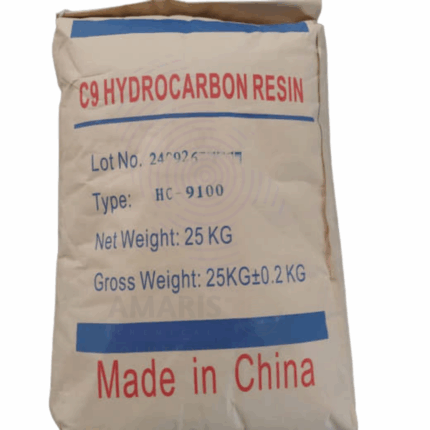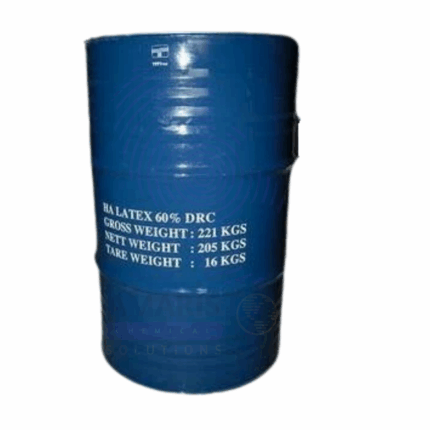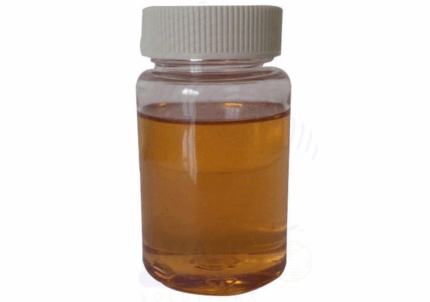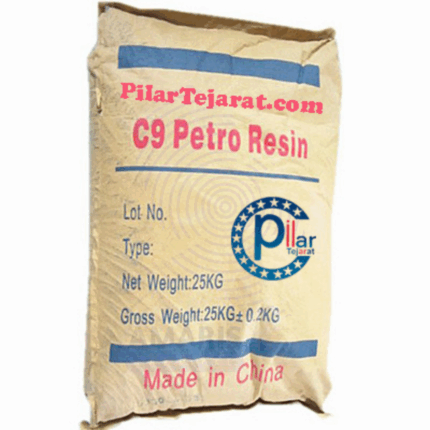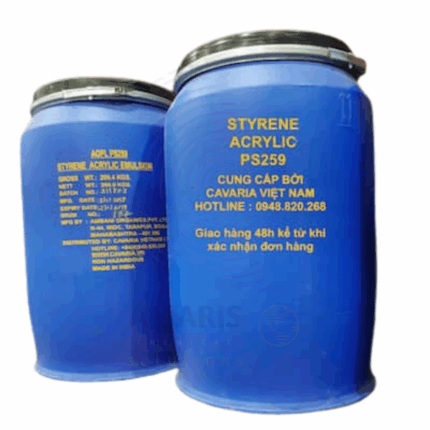Redispersible Powder
Whatsapp Order
Redispersible Powder (RDP) is a free-flowing, white powder obtained by spray-drying a water-based emulsion of polymers, typically vinyl acetate-ethylene (VAE), acrylic, or styrene-butadiene. When mixed with water, RDP re-emulsifies to form a stable dispersion with excellent adhesive, flexible, and film-forming properties. It is widely used in dry-mix construction materials to enhance workability, flexibility, impact resistance, water retention, and adhesion. The product is supplied in moisture-resistant 25kg bags and is compatible with cement, gypsum, and other mineral binders.
Description
Table of Contents
Toggle
Redispersible Powder
Primary Uses
- Construction Industry
- Used in tile adhesives and tile grouts to enhance adhesion, flexibility, and water resistance.
- Incorporated in cement and gypsum-based plasters, renders, and skim coats to improve workability and reduce cracking.
- Added to self-leveling floor compounds for better flow and strength.
- Used in external insulation finishing systems (EIFS) to provide flexibility and adhesion to insulation panels.
- Improves crack-bridging ability and tensile strength in waterproofing membranes and coatings.
- Enhances mortar and repair compounds for structural patching and overlays.
- Used in decorative finishes and textured coatings for improved cohesion and surface smoothness.
- Dry Mix Mortars
- Enhances water retention, open time, and adhesion in ready-mix dry mortars.
- Reduces shrinkage and improves durability in repair mortars and grouts.
- Essential in thermal insulation mortars for bonding EPS/XPS boards.
- Paints & Coatings
- Used in powder-based paints and primers to allow redispersion with water during application.
- Improves film formation and flexibility in elastomeric and cementitious coatings.
Secondary Uses
- Ceramics and Stone Bonding
- Used in ceramic tile adhesives for vertical or high-traffic installations where strong bonding is required.
- Waterproofing Systems
- Added to bitumen- or cement-based waterproofing membranes to increase flexibility and adhesion.
- Insulation Systems
- Used in soundproofing and fire-resistant mortars where elasticity and bonding are critical.
- Masonry Repair
- Incorporated into crack repair fillers and façade renovation products for lasting adhesion and reduced brittleness.
- DIY Repair Products
- Used in home repair dry powders for patching and filling small surface defects.
KEY PRODUCT FEATURES
1. Basic Identification Attributes
- Chemical Name (IUPAC): Varies by composition (e.g., vinyl acetate-ethylene copolymer)
- Common/Trade Name: Redispersible Powder
- CAS Number: Varies by polymer type
- HS Code: 3905.91.00
- Synonyms: RDP; redispersible polymer powder; re-emulsifiable polymer
2. Physical & Chemical Properties
- Physical State: Free-flowing powder
- Color & Odor: White or off-white; mild or neutral odor
- Solubility: Dispersible in water
- Bulk Density: 300–600 kg/m³ (typical)
- pH: 5.0–9.0 (in water dispersion)
- Particle Size: Fine powder; typically < 200 µm
- Film Formation Temperature (MFFT): ~0–10°C depending on polymer type
3. Safety & Hazard Attributes
- GHS Classification: Not hazardous under normal conditions
- Toxicity: Non-toxic; avoid inhalation of dust
- Exposure Limits: Use dust control measures; refer to SDS for occupational limits
4. Storage & Handling Attributes
- Storage Conditions: Store in a cool, dry place away from humidity and direct sunlight
- Container Type: 25kg paper bags with PE liner or valve bags
- Shelf Life: Typically 6–12 months in sealed packaging under dry conditions
- Handling Precautions: Avoid generating dust; use in well-ventilated areas; reseal opened bags properly
5. Regulatory & Compliance Attributes
- Complies with: Industry standards for construction additives (e.g., EN 12004 for tile adhesives)
- VOC Content: Very low or zero VOC
- May conform to LEED and green building requirements
- Non-flammable, APEO-free, formaldehyde-free (depending on grade)
6. Environmental & Health Impact
- Biodegradability: Not readily biodegradable; inert polymer
- Ecotoxicity: Low; safe for use in construction under normal conditions
- Bioaccumulation: Not expected
- Waste Disposal: Dispose of in accordance with local regulations for construction materials
SAFETY HANDLING PRECAUTIONS
Safety Handling Precautions
- PPE Required: Dust mask or respirator, gloves, and safety goggles
- Handling Guidelines: Minimize dust; ensure ventilation; avoid breathing airborne particles
- Storage Measures: Keep containers tightly closed and stored in a dry environment to prevent clumping and degradation
First Aid Measures
- Inhalation: Move to fresh air; seek medical help if respiratory irritation occurs
- Skin Contact: Wash with soap and water; consult a physician if irritation persists
- Eye Contact: Rinse cautiously with water for several minutes; remove contact lenses if present; get medical attention if discomfort continues
- Ingestion: Rinse mouth with water; not expected to be toxic, but consult a doctor if necessary
Firefighting Measures
- Fire Hazards: May burn if exposed to extreme heat; polymer dust may be combustible
- Extinguishing Media: Foam, dry chemical, CO₂, or water spray
- Special Precautions: Use protective gear and breathing apparatus
- Hazardous Combustion Products: Carbon monoxide (CO), carbon dioxide (CO₂), and other polymer degradation products
Related products
Binder
A binder is a broad category of substances—organic or inorganic—used to hold different materials together in a cohesive mass. Common binders include natural polymers (starch, cellulose derivatives, proteins), synthetic resins (PVA, acrylics, phenolics), and inorganic binders (clays, cement, lime). They are essential in industries such as pharmaceuticals, construction, coatings, ceramics, adhesives, and printing, where they provide structural integrity, adhesion, and controlled release properties.
Domacryl
Domacryl is a high-performance acrylic polymer latex designed for use as a binder in water-based coatings, adhesives, sealants, and construction materials. It is a styrene-acrylic copolymer emulsion offering excellent film formation, adhesion, durability, and chemical resistance. Domacryl provides superior mechanical strength and flexibility in formulated products, making it ideal for applications requiring long-lasting protection and enhanced aesthetic qualities. The polymer is supplied as a stable aqueous dispersion with approximately 50% solids content, packed in bulk (190 kg drums) for industrial use.
Hycryl
Hycryl is a specialized acrylic copolymer resin designed primarily for industrial and cosmetic applications. It appears as a white to off-white powder or granules with excellent film-forming, adhesive, and thickening properties. Known for its compatibility with a wide range of solvents and plasticizers, Hycryl 77 provides excellent clarity, flexibility, and durability in coatings, adhesives, and personal care formulations. Its balanced molecular weight and functional groups enable it to deliver strong binding and aesthetic properties in both aqueous and solvent-based systems.
Hydrocarbon Resins
Hydrocarbon Resins C5 And C9 Petroleum Resins are synthetic petroleum-derived resins produced through the polymerization of C5 (pentene) and C9 (nonene) fraction monomers. These resins appear as pale yellow to amber solid materials, usually in pellet or flake form, characterized by tackifying and adhesive properties. C5 resins are derived from aliphatic hydrocarbons, while C9 resins originate from aromatic hydrocarbons. Often blended, these resins provide a balance of hardness, tackiness, and compatibility with various polymers. Widely used as tackifiers, binders, and modifiers, C5 & C9 hydrocarbon resins enhance performance in adhesives, coatings, rubber compounding, and more.
Latex
Latex is a natural or synthetic colloidal dispersion of polymer microparticles in an aqueous medium. Natural latex is harvested from rubber trees (Hevea brasiliensis) and appears as a milky fluid rich in rubber particles suspended in water. Synthetic latexes are produced from various monomers such as styrene-butadiene or acrylics. Latex exhibits excellent elasticity, flexibility, and adhesive properties. It is widely used in manufacturing gloves, balloons, coatings, adhesives, paints, and various molded products. Its film-forming ability, water resistance, and durability make it a versatile material across industries.
Linseed Oil Alkali Refined
Linseed Oil Alkali Refined is a vegetable oil extracted from flax seeds and then refined using alkali treatment to remove impurities, free fatty acids, and gums. This refining process enhances the oil’s stability, color, and odor, making it suitable for industrial, artistic, and manufacturing uses. It is a drying oil known for its excellent film-forming properties, quick drying time, and good adhesion to surfaces. Alkali refined linseed oil is widely used in paints, varnishes, inks, and as a raw material in chemical industries.
Petroleum Resin C9 Hydrocarbon
Petroleum Resin C9 Hydrocarbon is a thermoplastic hydrocarbon resin derived from the C9 fraction of petroleum cracking. It is a tackifying resin with excellent compatibility with various polymers, especially in adhesives, paints, rubber, and coatings industries. Known for its good color stability, fast curing, and strong adhesion properties, C9 Petroleum Resin enhances product performance in many industrial applications.
Styrene Acrylic
Styrene Acrylic is a copolymer emulsion combining styrene and acrylic monomers, widely used as a versatile binder in coatings, adhesives, and construction materials. It offers excellent film-forming properties, adhesion, water resistance, and durability. This product enhances the performance and longevity of paints, sealants, textiles, and paper coatings, with flexibility for both indoor and outdoor applications. Styrene Acrylic emulsions are designed to meet stringent industrial and environmental standards.


 Preservatives(food)
Preservatives(food) Flavor Enhancers
Flavor Enhancers Acidulants
Acidulants Sweeteners
Sweeteners Antioxidants
Antioxidants Colorants(food)
Colorants(food) Nutraceutical Ingredients (food)
Nutraceutical Ingredients (food) Nutrient Supplements
Nutrient Supplements Emulsifiers
Emulsifiers
 Collectors
Collectors Dust Suppressants
Dust Suppressants Explosives and Blasting Agents
Explosives and Blasting Agents Flocculants and Coagulants
Flocculants and Coagulants Frothers
Frothers Leaching Agents
Leaching Agents pH Modifiers
pH Modifiers Precious Metal Extraction Agents
Precious Metal Extraction Agents
 Antioxidants(plastic)
Antioxidants(plastic) Colorants (Pigments, Dyes)
Colorants (Pigments, Dyes) Fillers and Reinforcements
Fillers and Reinforcements Flame Retardants
Flame Retardants Monomers
Monomers Plasticizers
Plasticizers Polymerization Initiators
Polymerization Initiators Stabilizers (UV, Heat)
Stabilizers (UV, Heat)
 Antifoaming Agents
Antifoaming Agents Chelating Agents
Chelating Agents Coagulants and Flocculants
Coagulants and Flocculants Corrosion Inhibitors
Corrosion Inhibitors Disinfectants and Biocides
Disinfectants and Biocides Oxidizing Agents
Oxidizing Agents pH Adjusters
pH Adjusters Scale Inhibitors( water)
Scale Inhibitors( water)
 Antioxidants(cosmetic)
Antioxidants(cosmetic) Emollients
Emollients Fragrances and Essential Oils
Fragrances and Essential Oils Humectants
Humectants Preservatives
Preservatives Surfactants(cosmetic)
Surfactants(cosmetic) Thickeners
Thickeners UV Filters
UV Filters
 Fertilizers
Fertilizers Soil Conditioners
Soil Conditioners Plant Growth Regulators
Plant Growth Regulators Animal Feed Additives
Animal Feed Additives Biostimulants
Biostimulants Pesticides (Herbicides, Insecticides, Fungicides)
Pesticides (Herbicides, Insecticides, Fungicides)
 Active Pharmaceutical Ingredients (APIs)
Active Pharmaceutical Ingredients (APIs) Excipients
Excipients Solvents(pharmaceutical)
Solvents(pharmaceutical) Antibiotics
Antibiotics Antiseptics and Disinfectants
Antiseptics and Disinfectants Vaccine Adjuvants
Vaccine Adjuvants Nutraceutical Ingredients (pharmaceutical)
Nutraceutical Ingredients (pharmaceutical) Analgesics & Antipyretics
Analgesics & Antipyretics
 Analytical Reagents
Analytical Reagents Solvents(lab)
Solvents(lab) Chromatography Chemicals
Chromatography Chemicals Spectroscopy Reagents
Spectroscopy Reagents microbiology-and-cell-culture-reagents
microbiology-and-cell-culture-reagents Molecular Biology Reagents
Molecular Biology Reagents Biochemical Reagents
Biochemical Reagents Inorganic and Organic Standards
Inorganic and Organic Standards Laboratory Safety Chemicals
Laboratory Safety Chemicals Specialty Laboratory Chemicals(Special Laboratory Equipment)
Specialty Laboratory Chemicals(Special Laboratory Equipment)
 Demulsifiers
Demulsifiers Hydraulic Fracturing Fluids
Hydraulic Fracturing Fluids Scale Inhibitors(oil)
Scale Inhibitors(oil) Surfactants(oil)
Surfactants(oil) Drilling Fluids
Drilling Fluids
 Dyes and Pigments
Dyes and Pigments Bleaching Agents
Bleaching Agents Softening Agents
Softening Agents Finishing Agents
Finishing Agents Antistatic Agents
Antistatic Agents
 Admixtures
Admixtures Waterproofing Agents
Waterproofing Agents Sealants and Adhesives
Sealants and Adhesives Curing Compounds
Curing Compounds Concrete Repair Chemicals
Concrete Repair Chemicals Anti-Corrosion Coatings
Anti-Corrosion Coatings
 Surfactants(cleaning)
Surfactants(cleaning) Builders
Builders Enzymes
Enzymes Solvents (Cleaning)
Solvents (Cleaning) Fragrances
Fragrances
 Electronic Chemicals
Electronic Chemicals Catalysts
Catalysts Lubricants
Lubricants Photographic Chemicals
Photographic Chemicals Refrigerants
Refrigerants Automotive chemicals
Automotive chemicals Pyrotechnic Chemicals
Pyrotechnic Chemicals
 Biodegradable Surfactants
Biodegradable Surfactants Bio-based Solvents
Bio-based Solvents Renewable Polymers
Renewable Polymers Carbon Capture Chemicals
Carbon Capture Chemicals Wastewater Treatment Chemicals
Wastewater Treatment Chemicals
 Pigments
Pigments Solvents(paint)
Solvents(paint) Specialty Coatings
Specialty Coatings Binders/Resins
Binders/Resins Additives
Additives Driers
Driers Anti-Corrosion Agents
Anti-Corrosion Agents Functional Coatings
Functional Coatings Application-Specific Coatings
Application-Specific Coatings
 Fresh Herbs
Fresh Herbs Ground Spices
Ground Spices Whole Spices
Whole Spices Spice Blends
Spice Blends Dried Herbs
Dried Herbs
 Leavening Agents
Leavening Agents Dough Conditioners
Dough Conditioners Flour Treatments
Flour Treatments Fat Replacers
Fat Replacers Decoratives
Decoratives Preservatives(baking)
Preservatives(baking)
 Plasticizers & Softeners
Plasticizers & Softeners Reinforcing Agents
Reinforcing Agents Adhesion Promoters
Adhesion Promoters Vulcanizing Agents
Vulcanizing Agents Antidegradants
Antidegradants Blowing Agents
Blowing Agents Fillers & Extenders
Fillers & Extenders Accelerators & Retarders
Accelerators & Retarders